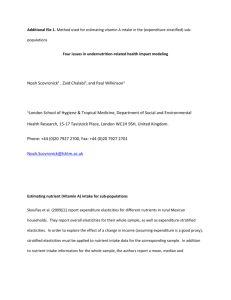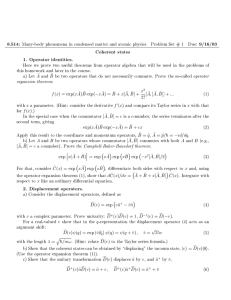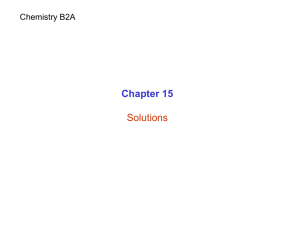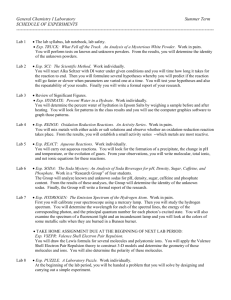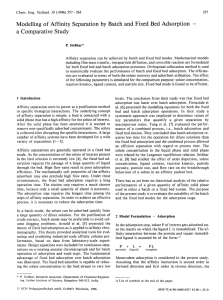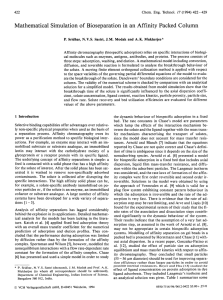A formula for predicting advection-dispersion in the vadose zone
advertisement
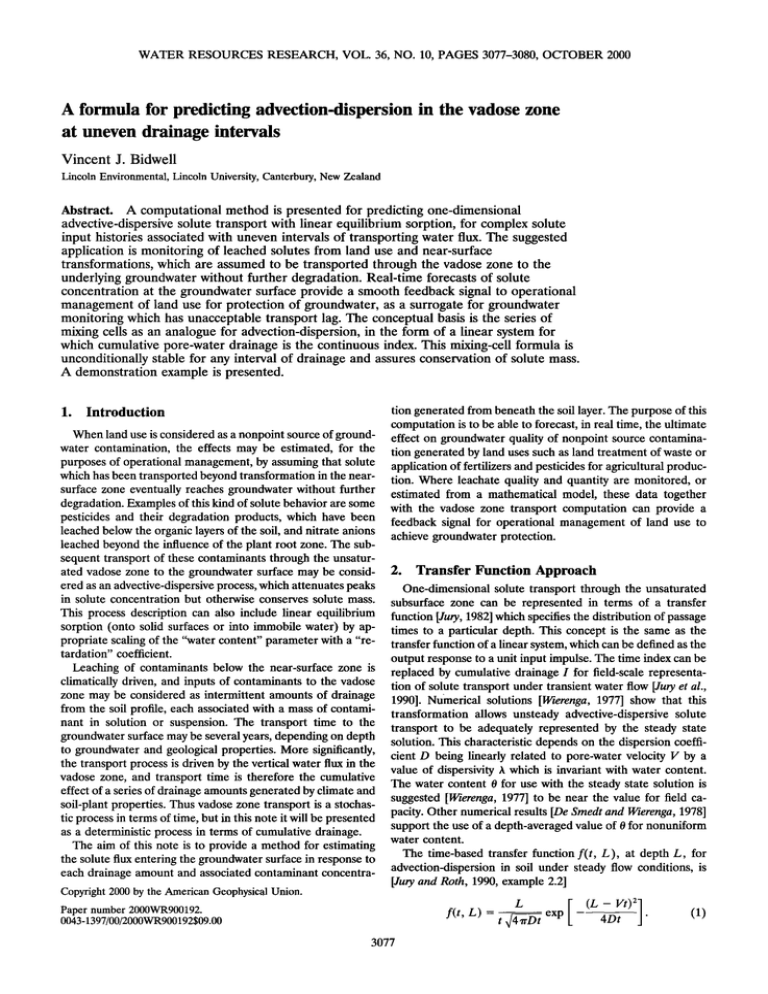
WATER RESOURCES RESEARCH, VOL. 36, NO. 10, PAGES 3077-3080, OCTOBER 2000
A formula for predictingadvection-dispersion
in the vadosezone
at unevendrainage intervals
Vincent
J. Bidwell
Lincoln Environmental,Lincoln University,Canterbury,New Zealand
Abstract. A computationalmethodis presentedfor predictingone-dimensional
advective-dispersive
solutetransportwith linear equilibriumsorption,for complexsolute
input historiesassociated
with unevenintervalsof transportingwater flux. The suggested
applicationis monitoringof leachedsolutesfrom land use and near-surface
transformations,
which are assumedto be transportedthroughthe vadosezone to the
underlyinggroundwaterwithout further degradation.Real-time forecastsof solute
concentrationat the groundwatersurfaceprovidea smoothfeedbacksignalto operational
managementof land use for protectionof groundwater,as a surrogatefor groundwater
monitoringwhich hasunacceptabletransportlag. The conceptualbasisis the seriesof
mixingcellsas an analoguefor advection-dispersion,
in the form of a linear systemfor
which cumulativepore-waterdrainageis the continuousindex. This mixing-cellformula is
unconditionallystablefor any interval of drainageand assuresconservationof solutemass.
A demonstrationexampleis presented.
1.
Introduction
When landuseis consideredasa nonpointsourceof groundwater contamination,the effectsmay be estimated,for the
purposesof operationalmanagement,by assumingthat solute
whichhasbeentransportedbeyondtransformationin the near-
tion generatedfrom beneaththe soillayer.The purposeof this
computationis to be ableto forecast,in real time, the ultimate
effect on groundwaterqualityof nonpointsourcecontamination generatedby land usessuchasland treatmentof wasteor
applicationof fertilizersandpesticides
for agriculturalproduction. Where leachatequality and quantityare monitored,or
estimatedfrom a mathematicalmodel, these data together
with the vadosezone transport computationcan provide a
feedbacksignalfor operationalmanagementof land use to
achievegroundwaterprotection.
surfacezone eventuallyreachesgroundwaterwithout further
degradation.Examplesof thiskind of solutebehaviorare some
pesticidesand their degradationproducts,which have been
leachedbelowthe organiclayersof the soil,and nitrate anions
leachedbeyondthe influenceof the plant root zone.The subsequenttransportof thesecontaminants
throughthe unsaturated vadosezone to the groundwatersurfacemay be consid- 2. Transfer Function Approach
ered asan advective-dispersive
process,
whichattenuatespeaks
One-dimensionalsolutetransportthroughthe unsaturated
in solute concentration but otherwise conserves solute mass.
subsurfacezone can be representedin terms of a transfer
This processdescriptioncan also include linear equilibrium function[Jury,1982]whichspecifiesthe distributionof passage
sorption(onto solidsurfacesor into immobilewater) by ap- times to a particulardepth. This conceptis the same as the
propriatescalingof the "watercontent"parameterwith a "re- transferfunctionof a linearsystem,
whichcanbedefinedasthe
tardation"
coefficient.
Leachingof contaminantsbelow the near-surfacezone is
climaticallydriven, and inputsof contaminantsto the vadose
zone may be consideredas intermittentamountsof drainage
from the soilprofile,eachassociated
with a massof contaminant in solution or suspension.The transport time to the
groundwatersurfacemaybe severalyears,dependingon depth
to groundwaterand geologicalproperties.More significantly,
the transportprocessis drivenby the verticalwater flux in the
vadosezone, and transporttime is therefore the cumulative
effectof a seriesof drainageamountsgeneratedby climateand
soil-plantproperties.Thusvadosezone transportis a stochastic processin termsof time, but in thisnote it will be presented
as a deterministicprocessin termsof cumulativedrainage.
The aim of this note is to providea methodfor estimating
the soluteflux enteringthe groundwatersurfacein responseto
eachdrainageamountand associated
contaminantconcentra-
outputresponseto a unit inputimpulse.The time indexcanbe
replacedby cumulativedrainageI for field-scalerepresentation of solutetransportundertransientwater flow [Juryet al.,
1990]. Numerical solutions[Wierenga,1977] show that this
transformation allows unsteady advective-dispersive
solute
transport to be adequatelyrepresentedby the steady state
solution.This characteristicdependson the dispersioncoefficient D being linearly related to pore-watervelocity V by a
value of dispersivity• which is invariant with water content.
The water content 0 for use with the steadystate solutionis
suggested
[Wierenga,
1977]to be near the valuefor field capacity.Other numericalresults[De Smedtand Wierenga,1978]
supportthe useof a depth-averaged
valueof 0 for nonuniform
water
content.
The time-basedtransferfunctionf(t, L), at depth L, for
advection-dispersion
in soil under steadyflow conditions,is
[Juryand Roth, 1990,example2.2]
Copyright2000 by the AmericanGeophysicalUnion.
Paper number2000WR900192.
f(t,L)=tx/4,rDt
exp 4Dt 1'
0043-1397/00/2000WR900192509.00
3077
(1)
3078
BIDWELL: TECHNICAL NOTE
Asa probability
density
function
(pdf)of traveltimet, (1) has
meanL/V andvariance
2DL/V3. The pdff(t, L) canbe
transformed
to a cumulative
drainagebasisf(I, L) by means
of the equivalence
f(t, L)d! = f(I, L)dI, substituting
D =
trationCin to thefirstcell.Thisprocedure
canbe developed
fromthegeneralsolution
of theordinarydifferential
equation
of r mixingcellsin series,eachcell with residencetime T. The
generalformof vanderMolen[1973,equation(35)]is then
XV, and then replacingthe travel distanceVt with I/0 so that
=Cin
+[C(0)
--Cin
]exp 1+m•
øm!Tm'
L exp
[(L-I/O)
2]' (2) Cr(t)
f(I,L)=I x/4•rXI/O
4XI/O
(3)
profiles,definedby
Thepdf(2) hasmeanL 0 andvariance
2LX02andrepresentsFor nonuniforminitial concentration
of superposition
leadsto sequential
applithe transferfunctionof solutetransported
by advection
with Cr(0),theprinciple
of the
hydrodynamic
dispersion.
Thereforedispersion
is assumed
to cationof (3) to the seriesof cellsfor computation
profileCr(t) at time t, whichcanbe illustrated
be determined
by the distance
I/0 traveledby the cumulative concentration
water flux and is independentof the transientflow behavior.
The transferfunction(2) completelycharacterizes
advective-dispersive
solutetransport,but it isnot a convenient
math-
ematicalform for prediction,especially
for complexsolute
input historiesand unevenintervalsof drainage.The next
sectiondescribes
an analogous
linear systemwhichis more
convenientfor computational
purposes.
3. Mixing-Cells Analogue
Solutetransportthrougha seriesof cells,within each of
for the first three cells as
Cl(t)=Cin+[Cl(O)--Cin]
exp
(--•)
c2(t)
--C,n+
[c•(O)
--Cin]
exp
(--•)
(1+•)
+[c2(0)
- el(0)]
exp
(-•)
(4)
c3(t)
= Cin
q-[Ci(0
) --Cin
] exp
whichperfectmixingoccurs,
isa concept
witha longhistory
of
dispersion
modeling
in hydrology
[e.g.,Bear,1969;Bajracharya
andBarry,1994].Thismodelisoftenpresented
asan approximation to the finite difference solution of the advection-
1+ • + 2.•
+[c2(0)
- c•(O)]
exp
(--•)
(1+•)
+[c3(0)
- c2(0)]
exp
(•) .
dispersion
equation,
anddevelopment
hasfocused
on problemsof numerical
dispersion
andstabilityrelatedto thesizeof
the spaceand time steps[Bajracharya
andBarry,1992].In
contrastto thesediscrete-time
models,seriesof mixingcells The generalform of (4) canbe rearrangedas
canalsobedescribed
in continuous
timebysystems
of ordinary
differential equationswhich include solute transformations
lumpedatthescaleofeachcell[Sardin
etal.,1991].Themixing
cellvolumes
arepredetermined
sothattheirdynamic
response
simulates
advective-dispersive
transport,
andthesetofcoupled
differentialequationsfor transportand transformation
are
solvedby standard
methods
for complex
linearsystems
[e.g.,
Bidwell,1999].
(3), (4), and (5) incorporate
the imMuch of the mathematicsof mixing-cellsystemshas Thesegeneralsolutions
that the inputfluxconcentration
c•, is conemergedfrom chemicalengineering
andthe theoryof chro- plicitassumption
matography.Van der Molen [1956] applied the chromato- stant over the time inte•al { 0 t }.
Bidwell[1999]developed
a form of the m•ng cellmodel,
graphic
theoryof Glueckauf[1949],
whichincludes
linearequilinear,equilibrium
and
libriumsorption,to leachingof salinesoils.He describes
the with flowbasisI, whichincorporates
solutetransformation.
For linearequilibrium
transportprocess
in termsof soil-waterflow (I), appliesthe nonequilibrium,
eachcell hasa residentvolumeper unit crosssecprincipleof superposition
of analytical
solutions
for complex processes,
tion
[L]
equal
to 2XOR(instead
of residence
timeT), where
salinity
profiles,
andestimates
theparameter
"theoretical
plate
Cr(t)
=exp
• 5 m•rmCr-m(O)
()•r-l(
tm )•
+{1-exp
(•)[••o
(mt•;m)]}Cm
ß (5)
thickness" from measurements of chloride ion concentration.
the retardation coefficient R is the ratio of total mass to dissolved mass on a soil volume basis.This is the same as the van
Thisapproach
hasessentially
thesametheoretical
basisas(2),
involves
onlyequilibrium
and the theoreticalplatethickness
is equivalent
to 2•. In a derMolen[1973]modelif theprocess
transfer
of
solute
within
the
water
phase,
for
which
R = 1. For
subsequent
monograph
[vanderMolen,1973]thisdimension
is
ontosolidsurfaces,
for whichR > 1, theproduct
R0
called"effective
mixinglength,"andthe soilprofileis consid- sorption
asa singleparameter
for calibration
pureredas a seriesof mixingreservoirs
for whichthe dynamic canbe considered
Solutemass
response
is shownto simulatecloselythe analyticalsolutions posesif 0 andR are not knownindependently.
balance
of
a
cell
is
described
by
a
differential
equation
with
fromGlueckauf[1949].
Thiscomparison
isachieved
byimplicdrainage
I asthecont•uous
index(•steadoft•e t):
itlyequating
thetimebasist andresidence
timeT of a mixing cumulative
reservoir
to theflowbasis
I andthewatercontent
2X0,respecdc
tively,of a theoreticalplate.This equivalence
is the sameas
2XOR
• + c = C,n,
(6)
that between(1) and (2).
A computational
methodisalsoprovided
for calculating
the where c•, is the influent soluteconcentration.A seriesof n
soluteconcentration
Cr(t) in cellr at timet, giventhe initial cells,eachdescribed
by (6), is a lineardynamicsystem
with a
concentration
c(0) in eachof the cellsandinputfluxconcen- transferfunctionwhichis the gammadistribution
BIDWELL:
f(I, n)= (n- 1)!(2AOR)
nexp-2XOR'
TECHNICAL
(7)
Thepdf(7) hasmean2nXORandvariance
4nX2(0R)2.If the
NOTE
E 70
-a- Monitoredat 0.7 rn
c 60
._o
-e-
Forecast
at 15 m
• 50
observationdepthL is representedby n cells,then L = 2nX,
(•
the meanis L OR, andvarianceis 2LA(0R)2. The transfer
o 30
functionsof the advection-dispersion
process(2) and the mixing-cellmodel (7) havethe samemean and variancefor n =
L/2A and R = 1. The matchbetweenthe two functions(2)
and (7), over the full rangeof drainageI, improveswith increasingnumber of cellsand is very closefor n greaterthan
40
z
& 20
z
0
¾•_
_,i . i- ._i -l•r.-,=,•li
i
i
i = i..
0
100
200
300
400
500
600
,
,
700
800
900
Cumulativedrainage(mm)
about 10.
Figure 1.
4.
3079
Forecasts of nitrate-N concentration at the
groundwatersurface(15 m depth), associated
with monitored
leachateconcentrations
from 0.7-m-deeplysimeters,as demonstratedfor water content 0 = 0.13 and dispersivityX -
Computational Form
For practical monitoringof leachateinput to the vadose 0.88 m.
zonefrom land treatmentof wastewater,for example,drainage
collectedfrom monolithsoil lysimetersmay be measuredand
sampledfor bulk solute concentrationat time intervals of
o(k) m
about i month. The volume collectedat the kth monitoring
bin(k)=m!
(12)
eventis expressed
asa drainageintervaldI(k), whichdepends
on soil-waterresponseto climateand irrigationevents,and the into (10) and calculatingthe coefficientsbm(k) from the secorresponding
bulk soluteconcentrationci,,(k) is considered quence
to be constantduring dI(k). By substitutingthe following
bo(k) = 1
equivalences
into (5)
b(k) = .(k)b0(k)
½r(k) = Cr(t)
(13)
½r(k -- 1) • ½r(O)
½in(k)•½in
(8)
bin(k) -
dI(k) = t
m
bm-l(k)
ß
ß
2XOR = T
ß
and writing
d/(k)
a(k)= 2XOR'
(9)
The valueof the bm(k) coefficients
mayhaveverysmallvalues
as m increases,dependingon the value of a(k), and truncation of the process(13) may be considered.However, the
author prefersto completethe full sequenceand thus avoid
havingto test for lossof solutemass.
(5) then becomes
5.
½r_m(k1))
]
Demonstration Example
An exampleof the use of the computationalmethod (9)cr(k
) = exp[-a(k)]
m!
(13) is demonstratedwith a seriesof flux-averagednitrate-N
concentrationdata ci,,(k) and averagedrainagefluxesdI(k),
collectedfrom four monolithsoil lysimetersusedfor monitor(lO) ing a land treatmentsitefor meat-processing
wastewater[Bidwell, 2000]. These data were collected at approximately
monthlytime intervalsduringa 2-year trial for which the avThe formula (10) is unconditionally
stablefor any magnitude
of drainageinterval and assuresconservationof solutemass. eragedrainagewas400 mm/yr.The data (Figure 1) includea
significant"contaminationevent" when the waste treatment
The number of mixingcellsn requiredfor a model is deterarea was temporarilyoverloaded.The transportparameters0
mined from the dispersivityX and the depthL at which pre- and X have not been determined for the vadose zone beneath
diction is desired,accordingto
the site, and for the purposeof the presentdemonstration,
L
valueshavebeenusedfrom measurements
byEngesgaard
et al.
n =2X'
(11) [1996] for the unsaturatedzone of a sandyaquifer receiving
estimatedinfiltration of about 450 mm/yr. Their resultsfor
transportmodel to the tritium
The number of mixingcellsn, from (11), may be large, for fitting an advective-dispersive
example,n - 100 for depth to groundwaterL - 20 m and profile in the --•20-m-deepvadosezone providevaluesof 0 dispersivity
X - 100mm.When the summationindexm in (10) 0.13 and X = 0.88 m. For the presentdemonstrationthe depth
has these large values,evaluationof the ratio a(k)m/m! by to groundwaterwas set to 15 m.
It was assumedthat for nitrate-N, R - 1, and there was no
meansof softwarelibraryfunctionsmaycausenumericalproblems.These terms are better calculatedby substituting
N transformationduring advective-dispersive
transport from
+ 1- exp
[-a(k)]
m•
ø m! ½in(k)'
=
3080
BIDWELL:
TECHNICAL
NOTE
beneaththe soil profile, at the 0.7-m monitoringdepth of the countsfor residentsoluteconcentrationthroughoutthe vadose
lysimeter,downthe remainingL = 14.3 m to the groundwater zone depth. However, the parametersOR and X are lumped
surface. The initial nitrate-N concentration in the vadose zone
valuesfor the depthof observation,andthe real distributionof
was set to the flux-averagedconcentrationfor the first 12 concentration
with depthmaybe different.
The computationalprocedureis intended for operational
months,
of4.4g/m3.Foreachinputof drainage
fluxdI(k) with
averageconcentration
Cin(k), the concentration
profilecr(k) monitoring and management rather than as a conceptual
was computed.Then a forecastedprofile c'r(k) was obtained model for scientificinvestigationand can supporta rangeof
to processing
monitoringdata.The examby applyingan additionalflux incrementdI' (k), at a concen- feasibleapproaches
tration c•,, equal to the averagesolute concentrationin the ple in this note demonstratesthe use of forecastedcontamimixingcells,to transportci,,(k) to the groundwater
surface.In nant effect at groundwaterlevel for supportingoperational
managementdecisions,whereasthe actual contaminantcontermsof (9) and (10) thiscomputationis
centrationin the groundwatermay be the result of land-use
dI' (k) = L O - dI(k)
eventsseveralyearsprevious.
c
= 2 c(a-
Acknowledgments. This note is basedon researchinto groundwater protectionfundedby the New Zealand Foundationfor Research,
Scienceand Technology,under contractLVL805. An anonymousreviewer alerted me to the previouscontributionof W. van der Molen.
r=l
dI'(k)
a'(k)= 2X0
(14)
References
ølt
(k)m
cr_m(k
)
m!
c;(k)= exp[-a'(k)]
Bajracharya,K., and D. A. Barry, Mixing cell modelsfor nonequilibrium singlespeciesadsorptionand transport,WaterResour.Res.,29,
_-
1405-1413, 1992.
olt(k) rn
+ 1 - exp[- a'(k)]
m!
cIn(k).
=
Bajracharya,K., andD. A. Barry,Note on commonmixingcellmodels,
J. Hydral., 153, 189-214, 1994.
Bear, J., Hydrodynamicdispersion,in Flow ThroughPorousMedia,
edited by R. J. M. De Wiest, chap.4, pp. 121-124,Academic,San
Diego, Calif., 1969.
Bidwell,V. J., State-space
mixingcell modelof unsteadysolutetransport in unsaturated
soil,Environ.Model.Software,14(2-3), 161-169,
By meansof (14), the estimatedeffect at groundwaterlevel,
c,,(k), can be computedon a real-timebasisfor eachsolute
1999.
flux input monitoredat the baseof the surfacesoil.The com- Bidwell,V. J., Decisionsupportfor protectinggroundwaterfrom land
treatment of wastewater,Environmetrics,
in press,2000.
putation takes into accountadvective-dispersive
transportof
the new input and the "background"concentrationprofile De Smedt,F., and P. J. Wierenga,Solutetransportthroughsoilwith
nonuniform water content, Soil Sci. Sac.Am. J., 42, 7-10, 1978.
generatedby the previousinput history.Figure 1 showsthe
Engesgaard,P., K. H. Jensen,J. Molson,E. O. Frind, and H. Olsen,
input data set and the corresponding
forecastsat groundwater
Large-scaledispersionin a sandyaquifer:Simulationof subsurface
levelfor the parametersspecifiedfor the demonstration.These
transportof tritium, WaterResour.Res.,32, 3253-3266, 1996.
!
forecastedvalues can be used, in real time, as feedback infor-
mationfor operationalmanagementof the land treatmentsite.
Groundwaterlevel forecastsprovide a more realistic signal
than lysimeterdata in terms of actual effect on groundwater,
and the smoothingeffectof the transportprocessimprovesthe
signal-to-noise
ratio. Monitoringthe actualgroundwatercontaminationis not usefulfor operationalmanagementbecause
of the long transportlag,whichfor the presentdemonstration
is about 4.6 years.
6.
Discussion
invariant
data, J. Chem. Sac., 152, 3280-3285, 1949.
Jury, W. A., Simulationof solutetransportusinga transferfunction
model, Water Resour.Res., 18, 363-368, 1982.
Jury, W. A., and K. Roth, TransferFunctionsand SoluteMovement
ThroughSoil, 226 pp., BirkhauserVerlag, Basel,Switzerland,1990.
Jury,W. A., J. S. Dyson,and G. L. Butters,Transferfunctionmodelof
field-scalesolutetransportundertransientwater flow,SoilSci.Sac.
Am. J., 54, 327-332, 1990.
Sardin,M., D. Schweich,F. J. Leij, and M. T. Van Genuchten,Modeling the nonequilibriumtransportof linearlyinteractingsolutesin
porousmedia:A review,WaterResour.Res.,27, 2287-2307,1991.
Van der Molen, W. H., Desalinization of saline soils as a column
The methodologydescribedin this note is for estimationof
one-dimensional
advective-dispersive
transportin porousmedia, in responseto complexdata seriesof solute inputs at
unevenintervalsof transportingwater flux. Dispersionis assumedto be linearly dependenton pore-watervelocitybut
otherwise
Glueckauf,E., Theoryof chromatography,
part VI, Precisionmeasurements of adsorptionand exchangeisothermsfrom column-elution
with water
content
and is therefore
com-
process,Soil Sci.,81, 19-27, 1956.
Van der Molen, W. H., Salt balance and leachingrequirements,in
DrainagePrinciplesand Practice,vol. II, Publ. 16, pp. 60-100, Int.
Inst. for Land Reclam.and Impr., Wageningen,Netherlands,1973.
Wierenga,P. J., Solutedistributionprofilescomputedwith steady-state
and transient water models, Soil Sci. Sac. Am. J., 41, 1050-1055,
1977.
pletelydescribedby the dispersivity
X. Linear equilibriumsorpV. J. Bidwell, Lincoln Environmental, P.O. Box 84, Lincoln Univertion processes
can be includedby meansof a retardationco- sity,Canterbury8150,New Zealand.(bidwellv@lincøln'ac'nz)
efficientR appliedto the transportingwater fraction 0 or by
calibration of the combinedparameter OR. In conceptual (ReceivedMay 4, 1999;revisedJune 16, 2000;
terms, the mixing-cellanalogueof advection-dispersion
ac- acceptedJune 19, 2000.)

